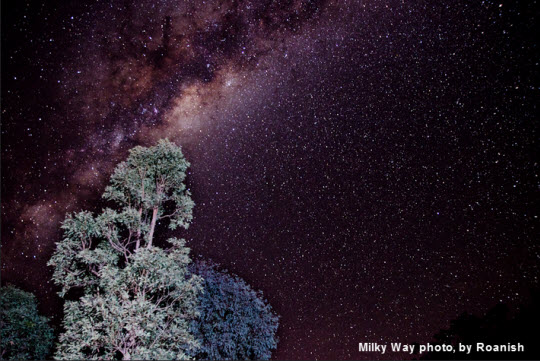September is a great month for observing the night sky. Conditions are (or should be) relatively mild, darkness falls reasonably early and there are plenty of objects to seek out. September is also the best month to fully appreciate one particular feature of the heavens, the ghostly river of light we call the Milky Way.
To accomplish this however you must seek out a dark location, away from stray light and at a time when moonlight is absent. Once you have located your 'dark oasis' allow time for your eyes to become dark adapted before directing your gaze skywards, normally 10 -15 minutes should do.

During September and early October the Milky Way dissects the sky from the NNE horizon, where it rises in Auriga, highlighted by scintillating Capella, before departing through Sagittarius straddling the SW horizon. In between, the Milky Way passes through Perseus, then the distinctive "W" pattern of Cassiopeia, where in binoculars a plethora of 'misty knots' are discernible. In larger instruments these resolve into glorious star fields and clusters. Moving through Cepheus, the Milky Way passes overhead directly through the long dimension of Cygnus the Swan (also known as the Northern Cross). Here, nearby its chief star Deneb the milky stream divides as though parted by a long sand bank midstream. Known as the 'northern rift', this island is actually a vast intervening dust cloud some 4000 light years distant and hundreds of light years in length that partly obscures the stellar multitude beyond. After Cygnus the Milky Way flows down through Aquila, passing bright Altair, before broadening its course through the constellation of Scutum, a small pattern rich in deep sky objects. The milky river then cascades down into Sagittarius, a constellation awash with nebulae and star clusters. Here amongst the celebrated star clouds of the Archer lies the centre of our galaxy.
Even today the sight of the Milky Way can be magical experience, but for thousands of year's ancient civilisations across the world revered its presence. To them it represented an overarching divine water course or spiritual path, guiding the soul of the departed into the afterlife. The true nature of this mystical ghostly light has been understood for over a century, a stellar citadel often depicted as a multi-armed spiral structure like a Catherine wheel on bonfire night. But in the last 5 years using data obtained from across the electromagnetic spectrum and from many varied sources, a clearer, more refined picture of our stellar metropolis has emerged.
Our galaxy is classed as a 'barred spiral' over 120,000 light years in diameter with just two major arms and two lesser ones. The central bar consists of stars orbiting in highly elliptical paths and is approximately 28,000 light years in length, bulging at the centre some 12,000 light years. Our own Sun is located on the edge of the 'Orion spur', a fairly quite stellar neighbourhood 26,000 light years from galactic centre and midway between two major arms, the nearest of which lies 6500 light years away. The arm's themselves are approximately 1500 light years thick. Once regarded as being the archetypal spiral galaxy; an isolated stellar island, observational studies reveal that our galaxy has cannibal tendencies, having absorbed several dwarf galaxies over the millennia. Astronomers believe that some of the many globular clusters visible are in fact the central cores of these. At the very heart of our galaxy lurks a black hole of some 4 million solar masses that 'feeds' on any star straying too close.
So when you next gaze up in awe at the Milky Way, remember, you are looking at the plane of our galaxy, the view we have of the spiral arms and galactic centre. Within his island universe, our Sun is just one of over 200 billion other stars around which orbit an estimated one trillion planets. How many other eyes i wonder gaze up at the majestic glow of our galaxy and contemplate other beings, it makes you think.
Image Credit:
- Milky Way taken by Roanish
- Log in to post comments
